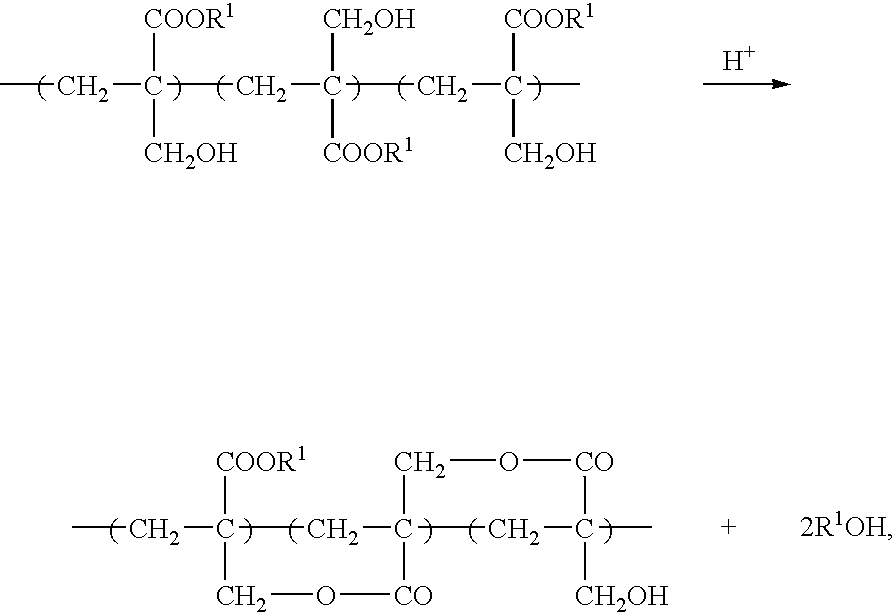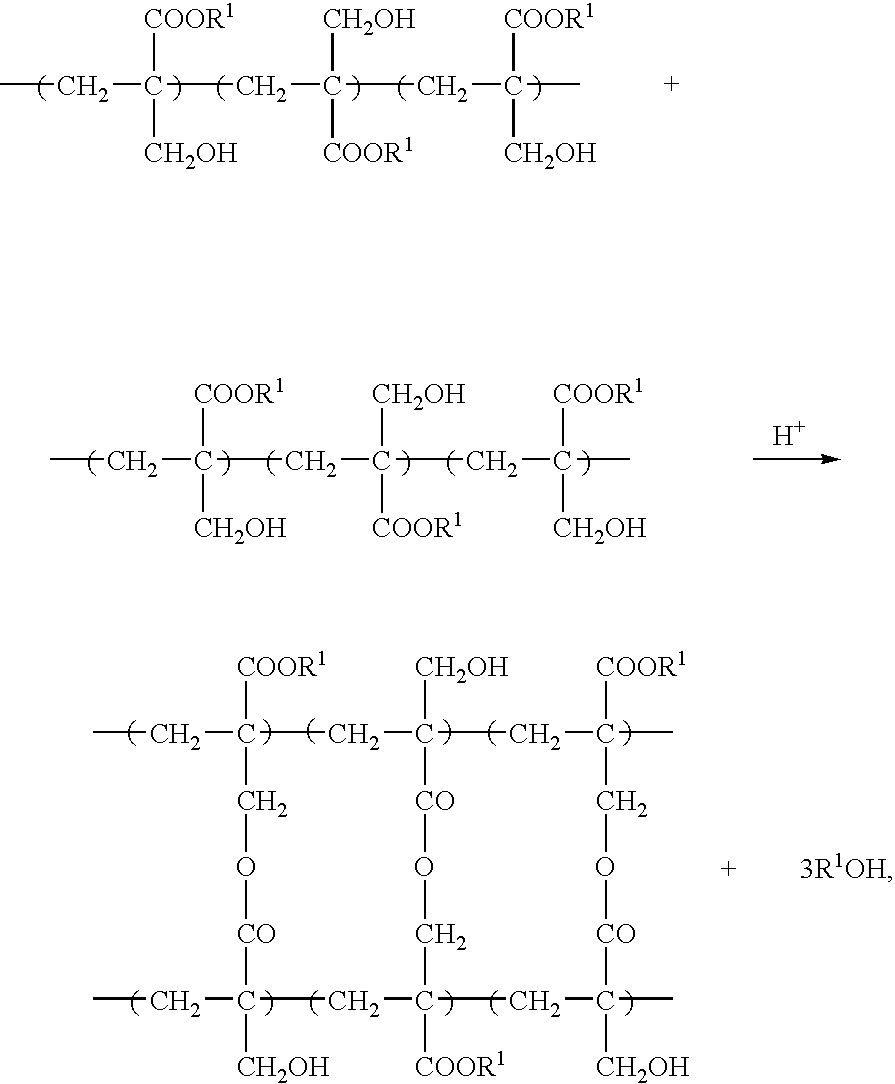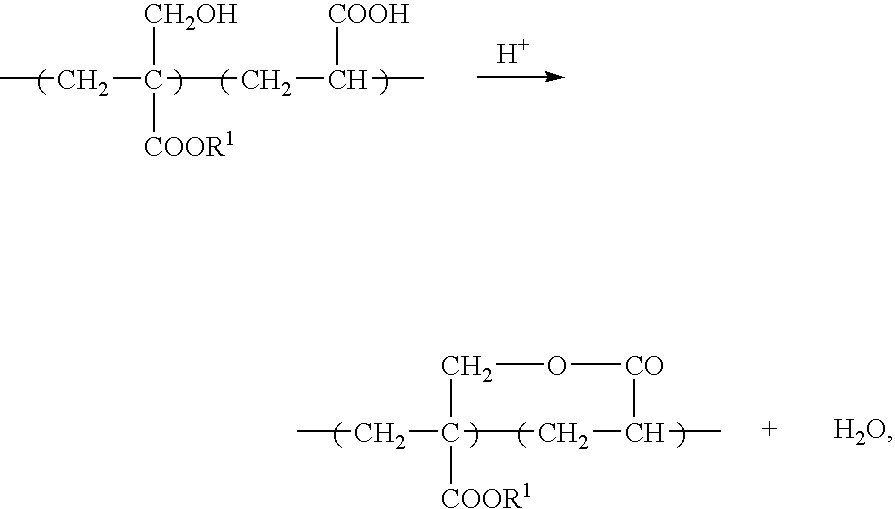Negative-working photoresist composition
a technology of photoresist and composition, applied in the field of negative-working photoresist composition, can solve the problems that the above-described type of photoresist composition cannot be quite satisfactory, and achieve the effects of excellent orthogonal cross sectional profile, low swellability, and high transparency
- Summary
- Abstract
- Description
- Claims
- Application Information
AI Technical Summary
Benefits of technology
Problems solved by technology
Method used
Image
Examples
example 1
A homopolymer of ethyl α-(hydroxymethyl)acrylate, referred to as the Polymer 1 hereinafter, was prepared in the following manner.
Thus, a polymerization mixture prepared by dissolving, in 200 g of tetrahydrofuran, 32.5 g (10.25 ml) of ethyl a-(hydroxymethyl)acrylate and 1.62 g of azobisisobutyronitrile as a polymerization initiator was heated at 70° C. for 3 hours under agitation to effect the polymerization reaction. After completion of the polymerization reaction, the polymerization mixture was poured into 1 liter of n-heptane to precipitate the polymer which was further purified by repeating the reprecipitation treatment followed by drying at room temperature under reduced pressure to give 20.5 g of a dried polymer which was a homopolymer of ethyl α-(hydroxymethyl)acrylate having a weight-average molecular weight of 12500 with a molecular weight dispersion of 2.1.
example 2
A copolymer of α-(hydroxymethyl)acrylic acid and ethyl α-(hydroxymethyl)acrylate, referred to as the Polymer 2 hereinafter, was prepared in the following manner.
Thus, a polymerization mixture prepared by dissolving, in 200 g of tetrahydrofuran, 5.1 g (0.05 mole) of α-(hydroxymethyl)acrylic acid, 26.0 g (0.20 mole) of ethyl α-(hydroxymethyl)acrylate and 1.62 g of azobisisobutyronitrile as a polymerization initiator was heated at 70° C. for 3 hours to effect the polymerization reaction. After completion of the polymerization reaction, the polymerization mixture was poured into 1 liter of n-heptane to precipitate the polymer which was further purified by repeating the reprecipitation treatment followed by drying at room temperature under reduced pressure to give 23.0 g of a dried polymer which was a copolymer of α-(hydroxymethyl)acrylic acid and ethyl α-(hydroxymethyl)-acrylate having a weight-average molecular weight of 13500 with a molecular weight dispersion of 2.2.
example 3
A copolymer of methacrylic acid and ethyl α-(hydroxymethyl)acrylate, referred to as the Polymer 3 hereinafter, was prepared in the following manner.
Thus, a polymerization mixture prepared by dissolving, in 200 g of tetrahydrofuran, 4.3 g (0.05 mole) of methacrylic acid, 26.0 g (0.20 mole) of ethyl α-(hydroxymethyl)acrylate and 1.62 g of azobisisobutyronitrile as a polymerization initiator was heated at 70° C. for 3 hours to effect the polymerization reaction. After completion of the polymerization reaction, the polymerization mixture was poured into 1 liter of n-heptane to precipitate the polymer which was further purified by repeating the reprecipitation treatment followed by drying at room temperature under reduced pressure to give 19.0 g of a dried polymer which was a copolymer of methacrylic acid and ethyl α-(hydroxymethyl)acrylate having a weight-average molecular weight of 15500 with a molecular weight dispersion of 1.9.
PUM
| Property | Measurement | Unit |
|---|---|---|
| Weight | aaaaa | aaaaa |
| Molecular weight | aaaaa | aaaaa |
Abstract
Description
Claims
Application Information
 Login to View More
Login to View More - R&D
- Intellectual Property
- Life Sciences
- Materials
- Tech Scout
- Unparalleled Data Quality
- Higher Quality Content
- 60% Fewer Hallucinations
Browse by: Latest US Patents, China's latest patents, Technical Efficacy Thesaurus, Application Domain, Technology Topic, Popular Technical Reports.
© 2025 PatSnap. All rights reserved.Legal|Privacy policy|Modern Slavery Act Transparency Statement|Sitemap|About US| Contact US: help@patsnap.com



